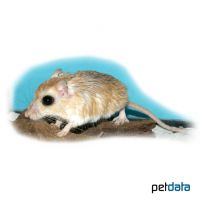Lesser Egyptian Gerbil (Gerbillus gerbillus)
| Lesser Egyptian Gerbil Gerbillus gerbillus | |
|---|---|
| Name | Lesser Egyptian Gerbil |
| Name Lat. | Gerbillus gerbillus |
| Family | Murids |
| Family lat. | Muridae |
| Order | Rodents |
| Order lat. | Rodentia |
| Origin | North Africa |
| Climate | Subtropical |
| Habitat | Rocky areas |
| Diet | Grains, herbs, hay, insects |
| Behavior | Nocturnal; territorial |
| Keeping | Group |
| Care Level | Easy |
| Life Span | 3-6 years |
| Protection | No |
| Metric Units | |
| Size | 9 cm |
| Temperature | Room temperature |
| Housing | A: 0.3 m² / H: 40 cm |
| US Units | |
| Size | 3.5" |
| Temperature | Room temperature |
| Housing | 3 ft² / 15" hight |
Distribution and habitat
The distribution area of the predominantly crepuscular and nocturnal Lesser Egyptian gerbils is the northern edge of the Sahara from Morocco to Jordan. There they live predominantly in dry and rocky areas, where they usually stay in self-dug burrows during the day.
Maintenance
Minimum dimensions for the enclosure:
| 1-2 animals | area: 0.3 m² | height: 40 cm |
| Each additional animal | Area: + 20 |
A terrarium placed in a bright (no direct sunlight), draught-free and quiet place is recommended, with ventilation openings at the sides, and it must not be tightly closed at the top.
The enclosure should be structured with rocks, roots, and branches, and provide hiding and shelter (rodent houses, tubes, clay caves, etc.). They need food and drinking containers (drinking bottles), a sand bath (chinchilla sand) for grooming, nesting material (hay, straw, etc.) and a substrate for digging. Commercially available small animal litter or a sand-soil mixture covered with some bark mulch and dry leaves is suitable as a substrate. The bedding depth should be at least 10 cm, better 20 cm. Nail material, such as untreated twigs and branches of fruit trees, as well as a rodent stone, must always be available to wear down their teeth. They should be kept at room temperature and their natural day-night rhythm should be respected.
Diet
Their diet is mainly vegetarian, but they also need animal protein. The diet consists of a low-fat grain mixture, available in specialized shops as "gerbil food", supplemented with forage hay, foxtail millet, some green food (root vegetables, wild herbs, zucchini, etc.) and a mineral stone. In addition, they need animal protein several times a week, such as live insects (crickets, house crickets, mealybug larvae), cottage cheese, a hard-boiled hen's egg or insect food for hedgehogs. Fruit must be offered only rarely and in very small quantities (risk of diabetes). Drinking water must always be available in hanging bottles or in stable, open containers and, like food, must be offered fresh daily
A varied diet promotes health and prevents deficiency symptoms.
Behaviour and compatibility
In the wild, they live in loose colonies with fixed territories. They should be maintained in a family group or same-sex group with adequate retreats. Unlike juveniles, adults should not be introduced into an unfamiliar group as they will fight. Animals must be separated immediately at the first sign of incompatibility.
Reproduction and breeding
In the male, the anal and genital openings are farther apart than in the female.
The gestation period is about 3 weeks. The average 1-6 young are born naked, blind and deaf, are independent after 4-6 weeks and should remain with the mother for a few days afterwards. After about 3 months they are sexually mature. The life expectancy is 3-6 years.
Important
During the day, activity phases alternate with rest periods. They are very lively and eager to dig. It has proven to cover a part of the enclosure with litter and the other part with a sand-earth mixture.
Running wheels must be injury-proof, have a closed running surface and back wall, with a diameter that the animals can run without bending their backs. As escape animals, they need sufficient retreat and hiding places, so the enclosure should also be somewhat elevated and not placed on the floor.
They should not be grabbed or pulled by the tail, as the skin can easily crack and detach. The animals should only be grasped by hand from below and lifted up. Particular attention should be paid to thorough hygiene and contamination should be removed regularly.
Further literature can be found in your pet store.
References
Text: petdata; Image: petdata
Source: W. PUSCHMANN, D. ZSCHEILE, K. ZSCHEILE (2009): Zootierhaltung - Tiere in menschlicher Obhut: Säugetiere, Harri Deutsch Verlag; BMEL (2014): Gutachten über Mindestanforderungen an die Haltung von Säugetieren
- Gemäß § 21 Abs. 5 Tierschutzgesetz idgF
